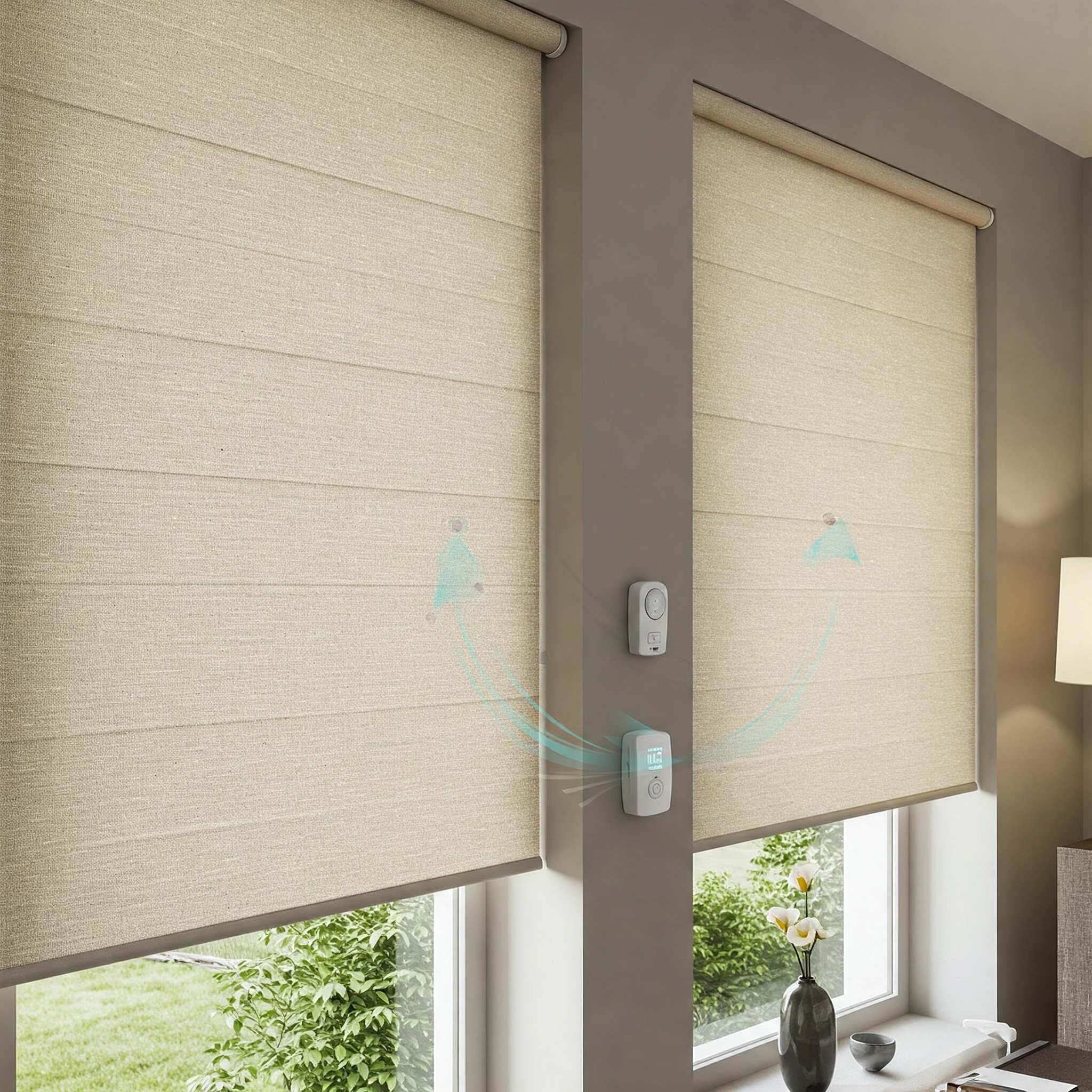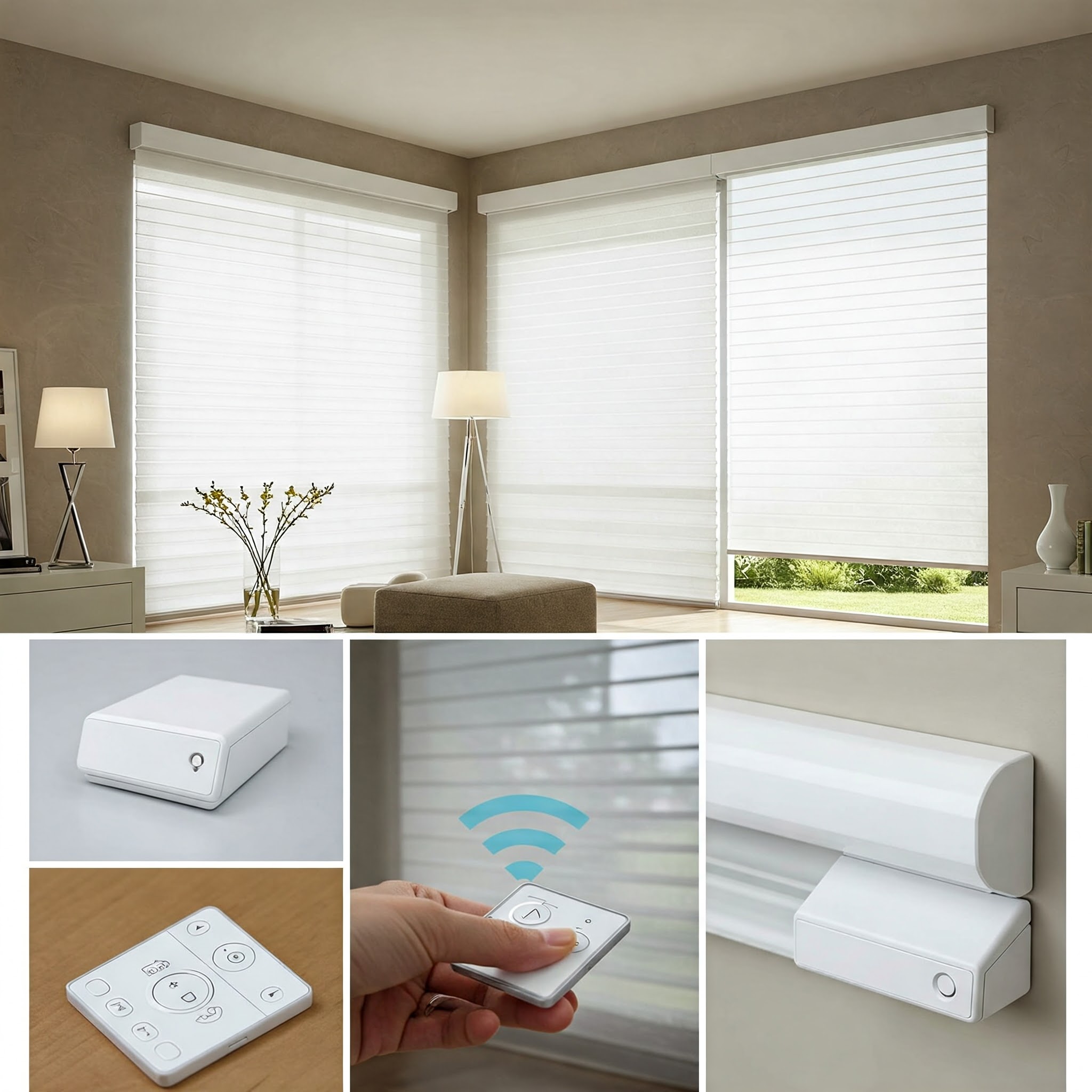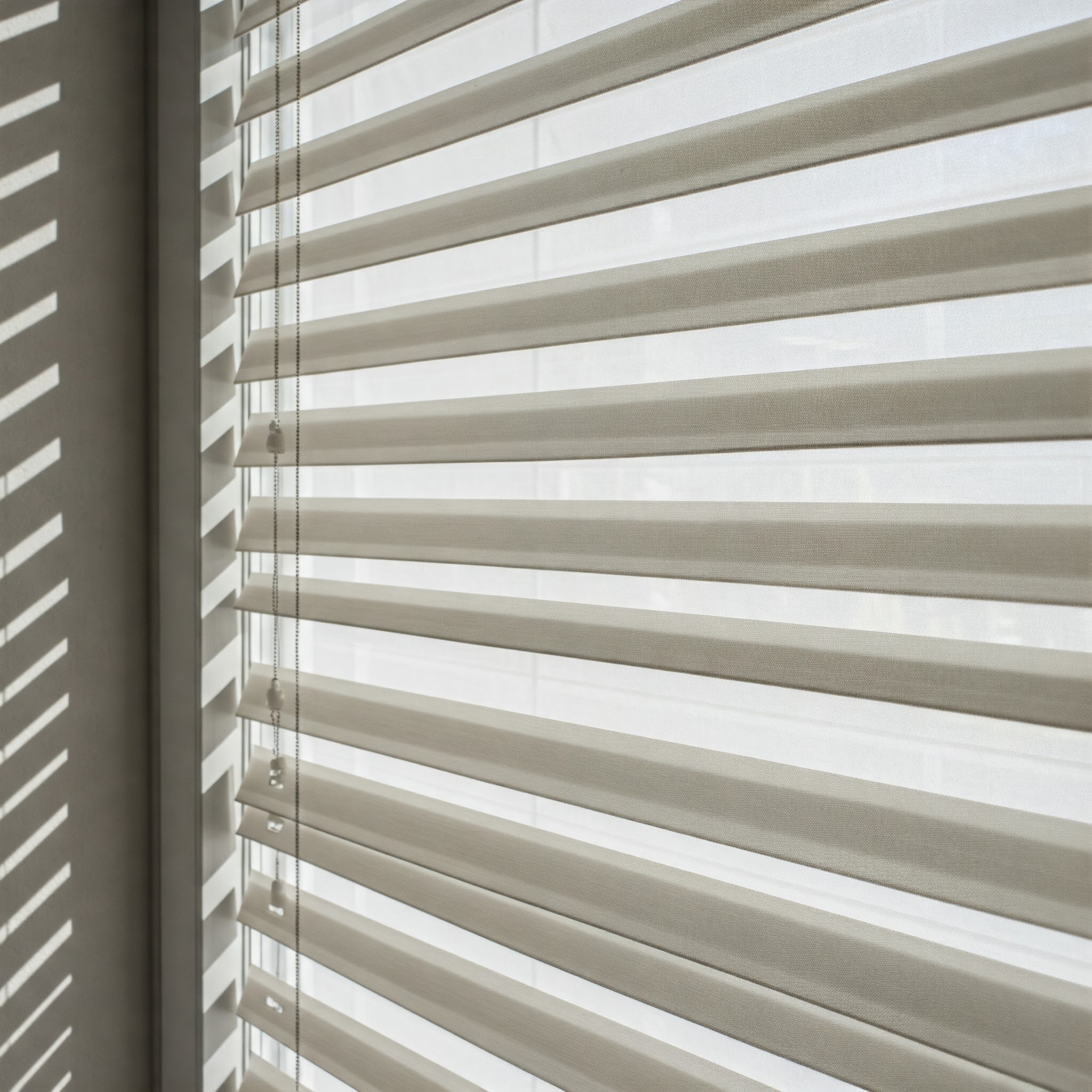Monsoon Blinds – Protection, Style & Comfort
What Are Monsoon Blinds?
Monsoon blinds are specially designed outdoor blinds that provide protection against heavy rain, strong winds, and harsh weather conditions. They are commonly used in balconies, patios, and open areas to shield spaces from rain while maintaining ventilation and visibility.
.jpeg)
Monsoon Blinds for Apartment Balconies
Monsoon blinds are used in apartment balconies primarily to provide protection from rain, wind, and harsh weather conditions while maintaining an open-air feel. They prevent water from entering the balcony, keeping the space dry and protecting furniture, plants, and other belongings from damage.
How Do Monsoon Blinds Work?
Monsoon blinds operate using a rolling mechanism that allows them to be easily raised or lowered based on weather conditions. They are available in both manual and motorized options, making them convenient for different settings.
.jpeg)
Privacy & Aesthetic Appeal of Monsoon Blinds
These blinds also enhance privacy, allowing residents to enjoy their balconies without external disturbances. Depending on the material, they can offer clear visibility while still providing protection.
Monsoon Blinds for Beachside Properties
Monsoon blinds are commonly used in beachside properties to protect outdoor spaces from strong winds, heavy rain, saltwater exposure, and intense sunlight. Coastal areas often experience unpredictable weather conditions, which can damage furniture and interiors.
.jpeg)
Monsoon Blinds for Protection Against Salt & Sand
Another major advantage of monsoon blinds in beachside locations is their ability to reduce salt and sand intrusion. The salty sea breeze can cause corrosion and wear over time, but these blinds act as a barrier, prolonging the lifespan of outdoor furniture and decor.
Monsoon Blinds for Restaurants
Monsoon blinds are widely used in restaurants, especially those with outdoor seating, to provide protection from rain, wind, dust, and harsh sunlight while maintaining an open and airy ambiance. They help create a comfortable dining experience for customers, allowing restaurants to continue operations even during bad weather. By preventing rainwater from entering outdoor dining areas, monsoon blinds keep furniture, flooring, and decor dry and in good condition, reducing maintenance costs.
Privacy & Cost Efficiency of Monsoon Blinds for Restaurants
In addition to weather protection, these blinds also enhance privacy for diners and reduce disturbances from street noise and dust, making the environment more pleasant. Many restaurants choose transparent or tinted monsoon blinds to maintain visibility while ensuring protection. Moreover, they help regulate temperature by blocking direct sunlight, keeping the space cooler and reducing air conditioning costs. With their durability, ease of use, and aesthetic appeal, monsoon blinds are an excellent investment for restaurants looking to maximize their outdoor space year-round.
.jpg)
How Monsoon Blinds Work
Monsoon blinds operate using a rolling mechanism that allows them to be easily raised or lowered based on weather conditions. They are available in both manual and motorized options, making them convenient for different settings. Manual blinds typically use a pulley or crank system, allowing users to roll them up or down by hand, while some models have a rope mechanism or rotating handle for smooth operation. On the other hand, motorized monsoon blinds come with an electric motor that can be controlled via a remote, switch, or smartphone app, making them ideal for larger spaces or commercial setups where automation is preferred. These blinds are made from waterproof materials like PVC, acrylic, or HDPE fabric, ensuring durability against heavy rains and strong winds. When fully extended, they provide complete protection, and when rolled up, they offer an open and unobstructed view. Some advanced motorized models even feature wind sensors that automatically retract the blinds during strong gusts, adding an extra layer of convenience and protection.
Key Components of Monsoon Blinds
Monsoon blinds consist of several key components that work together to provide durability, ease of use, and protection against harsh weather conditions. The main component is the fabric or screen material, which is typically made from PVC, acrylic, or HDPE fabric, offering waterproof, UV-resistant, and windproof properties while maintaining visibility if needed. The roller tube, usually made of metal or aluminum, allows the blind to roll up and down smoothly, keeping it taut and functional. Some blinds also include side tracks or guide rails, which help keep them in place during strong winds, preventing unnecessary movement or damage. A bottom bar is added to provide stability, ensuring the blinds do not sway in windy conditions.
.jpg)
Manufacturing Process of Monsoon Blinds
The manufacturing of monsoon blinds' plastic sheets, typically made from PVC or acrylic, involves advanced technologies to ensure durability, weather resistance, and flexibility. The process begins with extrusion, where heated PVC or acrylic material is forced through a mold to create uniform sheets with consistent thickness and strength. In cases where a more flexible material is required, the calendering process is used, where the heated material passes through rollers to achieve a smooth, transparent, and durable finish. To enhance performance, some sheets undergo coating and lamination, adding UV-resistant or anti-static layers to prevent yellowing, improve durability, and reduce dust accumulation.
Monsoon Blinds for Restaurants
Monsoon blinds are widely used in restaurants, especially those with outdoor seating, to provide protection from rain, wind, dust, and harsh sunlight while maintaining an open and airy ambiance. They help create a comfortable dining experience for customers, allowing restaurants to continue operations even during bad weather. By preventing rainwater from entering outdoor dining areas, monsoon blinds keep furniture, flooring, and decor dry and in good condition, reducing maintenance costs.
Privacy & Cost Efficiency for Restaurants
In addition to weather protection, these blinds also enhance privacy for diners and reduce disturbances from street noise and dust, making the environment more pleasant. Many restaurants choose transparent or tinted monsoon blinds to maintain visibility while ensuring protection. Moreover, they help regulate temperature by blocking direct sunlight, keeping the space cooler and reducing air conditioning costs. With their durability, ease of use, and aesthetic appeal, monsoon blinds are an excellent investment for restaurants looking to maximize their outdoor space year-round.

How Monsoon Blinds Work
Monsoon blinds operate using a rolling mechanism that allows them to be easily raised or lowered based on weather conditions. They are available in both manual and motorized options, making them convenient for different settings. Manual blinds typically use a pulley or crank system, while motorized blinds come with an electric motor that can be controlled via a remote, switch, or smartphone app.
Importance of UV Resistance in Monsoon Blinds
A UV-resistant sheet is essential in monsoon blinds to protect against the harmful effects of ultraviolet (UV) radiation from the sun. Continuous exposure to sunlight can cause regular plastic sheets to degrade, resulting in yellowing, brittleness, and reduced lifespan. UV-resistant sheets are specially designed with protective coatings or additives that absorb or reflect UV rays, preventing material deterioration and ensuring long-term durability.

Reinforcement and Finishing in Monsoon Blinds
For high-strength variants, reinforcement with polyester mesh is used in HDPE fabric-based blinds, increasing their tensile strength and wind resistance. Some sheets also undergo embossing and surface treatment, adding textures or anti-glare properties for improved aesthetics. The final steps involve heat welding and precision cutting, ensuring seamless edges and high durability against tearing or peeling.
Temperature Control and Aesthetic Appeal with Monsoon Blinds
In addition to extending the lifespan of the blinds, UV resistance also helps in temperature control by reducing heat buildup in outdoor spaces, making balconies, patios, and commercial areas more comfortable. It also prevents fading of furniture, flooring, and décor by blocking excessive UV exposure. For restaurants, resorts, and beachfront properties, where blinds are constantly exposed to sunlight, UV-resistant sheets are crucial for maintaining clarity, strength, and aesthetic appeal over time.
Durability and Maintenance of Monsoon Blinds
The lifespan of monsoon blinds depends on factors such as material quality, weather conditions, frequency of use, and maintenance. Generally, well-constructed monsoon blinds last between 5 to 10 years with proper care. PVC and acrylic blinds, especially those with UV-resistant coatings, typically have a lifespan of 5 to 7 years. HDPE fabric blinds, reinforced with polyester mesh, offer superior durability and can last 7 to 10 years. The lifespan also varies between manual and motorized blinds, where high-quality motorized systems can last as long as the fabric if well-maintained.

Cleaning and Maintenance of Monsoon Blinds
Cleaning monsoon blinds regularly helps maintain their durability, appearance, and functionality. Remove dust and debris using a soft cloth, duster, or a vacuum cleaner with a brush attachment. Prepare a mild cleaning solution by mixing liquid soap or detergent with warm water. Use a soft sponge or microfiber cloth for PVC and acrylic blinds, while for HDPE fabric blinds, a soft-bristle brush is recommended. Rinse with clean water and let the blinds air dry before rolling them up to prevent mold or stains.
Common Applications of Monsoon Blinds
Monsoon blinds are commonly used in various residential, commercial, and outdoor spaces to provide protection against rain, wind, and sunlight while maintaining ventilation and visibility. In apartments and homes, they are widely installed in balconies, patios, and terraces to shield against harsh weather while allowing residents to enjoy outdoor spaces comfortably. Restaurants, cafés, and resorts frequently use them in outdoor seating areas, enabling customers to dine in open spaces without being affected by rain or excessive heat. In beachside properties and coastal areas, monsoon blinds are essential for blocking strong winds and salty air, which can cause corrosion and discomfort. They are also commonly seen in shops, commercial buildings, and office spaces with open areas or large windows, where they help regulate temperature and reduce glare while enhancing privacy. Additionally, monsoon blinds are used in gardens, farmhouses, and poolside areas, offering weather protection without obstructing the view. Their durability, ease of use, and ability to withstand extreme conditions make them a practical choice for various outdoor and semi-outdoor environments.
Rain Protection Efficiency of Monsoon Blinds
Monsoon blinds provide significant protection against rain, but they may not always prevent 100% of water from entering, especially in extreme weather conditions. Their effectiveness depends on factors such as material quality, installation method, wind direction, and rain intensity.
.jpg)
Factors Affecting Rain Protection in Monsoon Blinds
High-quality PVC or acrylic monsoon blinds with sealed edges and proper installation can block most rainwater, keeping balconies, patios, and outdoor spaces dry. However, in cases of heavy storms, strong winds, or sideways rain, some water may seep through gaps at the sides, bottom, or edges if the blinds are not fully enclosed. Using side tracks or guide rails can improve protection by preventing water from entering through open spaces.
Ensuring Maximum Waterproofing with Monsoon Blinds
For 100% waterproofing, monsoon blinds should be combined with additional weatherproofing solutions, such as sealing gaps with silicone strips or using enclosed balcony designs. While they offer excellent rain protection, ensuring complete water blockage depends on proper installation and additional reinforcements.
.jpg)
Wind Resistance and Stability of Monsoon Blinds
The wind resistance of monsoon blinds depends on their material, thickness, mounting method, and reinforcement features. High-quality PVC or acrylic blinds can typically withstand wind speeds of 40-60 km/h, while HDPE fabric blinds with reinforced polyester mesh can handle stronger winds up to 80-100 km/h.
Enhancing Wind Protection with Monsoon Blinds
For areas exposed to high wind pressure, installing zip-track or side-channel systems helps keep the blinds securely in place, reducing the chances of them flapping or tearing. Additionally, motorized blinds with wind sensors automatically retract when wind speeds exceed safe limits, preventing damage. In coastal and storm-prone areas, using heavy-duty frames and secure fastening methods can enhance stability. However, during extreme storms or cyclones, it's advisable to roll up the blinds to prevent structural strain or potential damage.
Monsoon Blinds Installation Process
Installing monsoon blinds requires precise measurements, secure mounting, and proper alignment to ensure durability and effective protection against rain and wind. First, measure the width and height of the installation area to ensure a perfect fit. Next, decide on the mounting type, whether it will be fixed to the ceiling, wall, or inside a frame, depending on the structure of the space. Mark the drill points using a measuring tape and level, ensuring proper alignment for smooth operation. Drill holes and secure the mounting brackets with heavy-duty screws to provide strong support, especially in windy areas.
.jpg)
Finalizing Monsoon Blinds Installation
Once the brackets are in place, attach the monsoon blind roller securely, ensuring it locks properly into the brackets. If installing motorized blinds, connect the power supply and test the operation. For enhanced wind resistance, side guides or zip-track systems can be installed to keep the blinds stable, and bottom weights should be used for manual blinds to prevent flapping. After installation, roll the blinds up and down multiple times to check for smooth movement and make any necessary adjustments. Finally, sealing any gaps with weatherproof strips can improve rain protection. A well-installed monsoon blind not only enhances the functionality of outdoor spaces but also provides long-term protection against harsh weather conditions.
Advantages of Monsoon Blinds
Monsoon blinds offer several advantages over other types of outdoor blinds, making them a preferred choice for balconies, patios, restaurants, and coastal areas. One of their biggest benefits is weather resistance, as they are specifically designed to withstand heavy rain, strong winds, and UV exposure, unlike traditional fabric blinds that may fade or tear over time. Their waterproof nature ensures that outdoor spaces remain dry and usable even during the monsoon season. Additionally, monsoon blinds provide clear visibility while offering protection, especially in transparent PVC or acrylic variants, unlike conventional roller blinds or bamboo blinds, which may block the view.
Durability and Wind Resistance of Monsoon Blinds
Another advantage is their durability, as monsoon blinds are made from strong materials like PVC, acrylic, or HDPE fabric, which last longer and require less maintenance compared to fabric blinds that may accumulate dust and moisture. They also offer better wind resistance, especially when installed with zip-track systems or side guides, preventing them from flapping or getting damaged in strong winds. Unlike pergola or awning shades, which provide only sun protection, monsoon blinds offer all-weather protection, making them a more versatile choice.
.jpg)
Ease of Use and Maintenance of Monsoon Blinds
Furthermore, monsoon blinds are available in both manual and motorized options, providing ease of operation. The motorized versions come with remote control or wind sensors that automatically roll them up in extreme weather conditions. Lastly, they are easy to clean and maintain, as they do not absorb water or dust like fabric blinds. With their functionality, durability, and superior weather resistance, monsoon blinds are an excellent investment for anyone looking to protect outdoor spaces without compromising visibility or aesthetics.
Wind and Rain Resistance of Monsoon Blinds
Monsoon blinds are specially designed to withstand heavy wind and rain through a combination of strong materials, secure installation, and advanced support systems. The primary factor in their wind and rain resistance is the high-quality materials used, such as thick PVC, acrylic sheets, or HDPE fabric with reinforced mesh, which provide durability and flexibility. These materials are waterproof, UV-resistant, and tear-resistant, making them ideal for outdoor use.
.jpg)
Structural Stability of Monsoon Blinds
To ensure stability in strong winds, monsoon blinds can be installed with zip-track systems, side rails, or guide channels that keep the blinds securely in place, preventing them from flapping or detaching. Some designs include heavy bottom bars or weighted rods, which add extra stability by keeping the blinds taut. For areas prone to extreme weather, motorized blinds with wind sensors can automatically retract when wind speeds exceed a safe limit, protecting both the blinds and the structure
Proper Installation of Monsoon Blinds for Maximum Resistance
Proper installation is also crucial for wind resistance. Monsoon blinds must be securely mounted with strong brackets, corrosion-resistant screws, and heavy-duty fixtures to withstand high pressure. In coastal or high-wind areas, additional support frames or reinforced edges can be used to further enhance durability. With these structural reinforcements and high-quality materials, monsoon blinds provide reliable protection against harsh weather while maintaining visibility and ventilation.
Performance of Monsoon Blinds in Extreme Weather
Monsoon blinds can be used in extreme cold and hot conditions, as they are designed to provide weather protection beyond just rain and wind resistance.
.jpg)